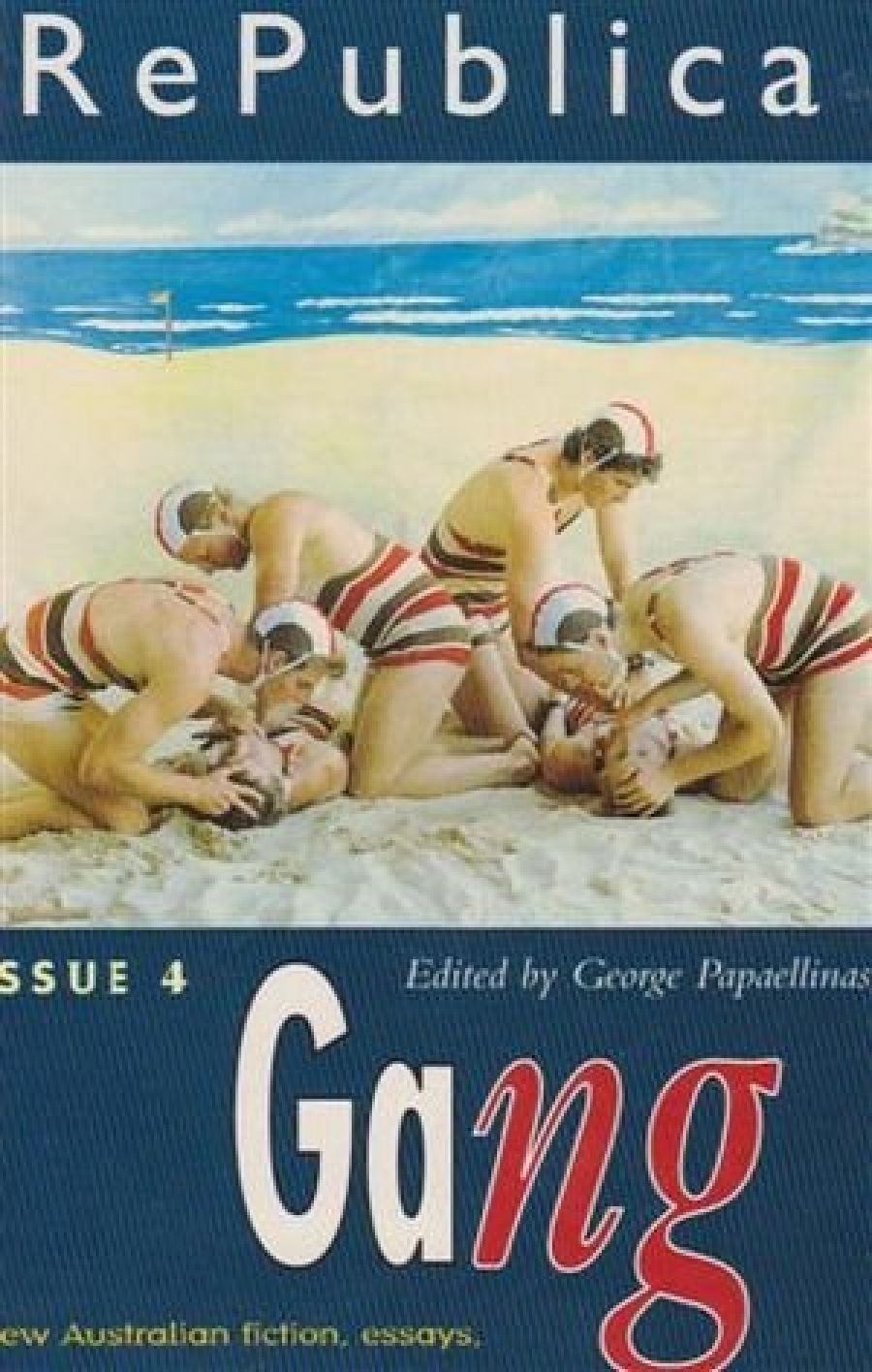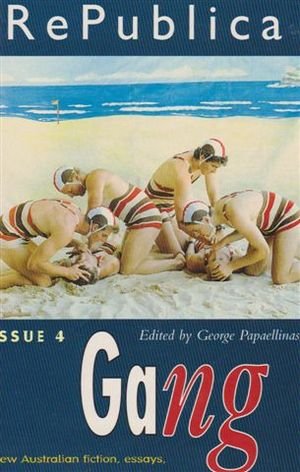
- Free Article: No
- Contents Category: Short Stories
- Review Article: Yes
- Article Title: Our Gang
- Online Only: No
- Custom Highlight Text:
Is it only reviewers who read literary magazines through as if they were books while most people dip into them? In the hope that a theme for each issue would hold the attention of readers RePublica this time has centred on Gang.
- Book 1 Title: RePublica
- Book 1 Subtitle: Gang 4
- Book 1 Biblio: Angus & Robertson, $l7.95 pb, 218pp
- Book 1 Cover Small (400 x 600):

- Book 1 Cover (800 x 1200):

However, our gang of editors and contributors is not interrogated. Their wish for an Australian New York Reviewof Books alongside RePublica as our own Granta shows how inventive the cringe can remain. Since an issue of Meanjin would cost less than half the recommended retail price of RePublica and offers the same minimalist fees to contributors, two distinct questions arise: is RePublica the answer to anything? should its contents have been published anywhere?
Although some of the pieces might not have been written without editorial initiative, all of the items could have found other homes and several deserved wider circulation. For instance, Tony Birch’s account of how the defenders of the Fitzroy baths contributed to a stereotyping of that suburb should have been in the Sunday Age. Henry Reynolds’s reminiscence of Eddie Mabo could have been taken in by the Courier-Mail under its new editor.
Janaczewska’s delight in jammaking is the kind of writing that the Good Weekend should encourage just as it might well have published Kalantzis’ autobiographical lecture, ‘The House of Brides’, which journeys from frock shop to a chair in academe.
Barry Hill’s nineteen-page sequence of poems reflecting on the Russian revolution would have been the hardest to place elsewhere, but because of its length, not from any arcaneness, though some acquaintance with the left during this century is necessary to comprehend its allusions. The verse is free but never merely cut-up prose. His patterning replicates the thought as when
There are nightingales
in expectant clauses, and line
breaks that sketch the ghostly
body of the poem.
Style varies to accord with the angle of view. Hill’s fractured structure, leaning towards Mayakovsky, should remind fiction writers such as Gemmell how old fashioned their experiments appear. The fictions of Silber and Kranz are as; predictable in their literary self-consciousness as any sting-in-the-tail ending from O. Henry. McGirr’s ‘Champagne’ surprises because it almost tells its story.
When Tsiolkas writes that News Corp. and Microsoft are ‘spending vast sums of capital on the infrastructure of the telecommunication networks’ he provides an instance of the ‘Pulp Theory’ that he claims to deplore. In fact Microsoft lays no cable and launches no satellite but makes operating systems for computers which it does not manufacture, any more than it produces telecommunications equipment. Rather than build infrastructure, Microsoft is spending ‘vast sums’ on the marketing of Windows to maintain its oligopolistic command of the market.
Tsiolkas’s reference to News Corp. is true although even with the recent injection of $US2b from telephone corporation MCI, Mass Murdoch is a minor player compared with the new Disney-ABC conglomerate. To comprehend globalisation, Australian commentators need to get beyond our Murdoch fixation. Moreover, all media theorisers need to become pre-Post-Modem and learn how to read balance sheets as well as bodies.
One link between Murdoch and Bill Gates came too late for Tsiolkas’ consideration. To launch Windows on 24 August 1995 Microsoft sponsored that day’s issue of The Times as if it were a football match. For £335,000 sterling the corporation got a twenty-four-page supplement, several pages of advertisements and presumably some expectation that their product would not be scrutinised too scrupulously.
The only prose piece too long for most alternative publications is Robert Dessaix ‘s ‘Death to Art’, with its starting point in Sontag on illness as metaphor. His complaint about the lack of AIDS’ art of value’ suffers from an instamatic view of creativity. Perhaps the latency period for ‘art of value’ is longer than for HIVAIDS? Tolstoy on cancer and Turgenev on typhus were dealing with diseases that had become part of folklore. The plea for AIDS ‘art of value’ within the first fifteen years of the plague is as misguided as ACT-UP’s demand for a magic bullet by yesterday, just as that ‘I-want-it-allnow’ syndrome contributes to a commodification of sex which spreads the virus. Dessaix wants art that will outlast the present, but paradoxically expects it immediately.
If we reconsider Dessaix ‘s concern about the politicisation of AIDS against Benjamin’s claim that the Nazis had aestheticised politics while the Bolsheviks had politicised aesthetics we can see that such distinctions have been capsized by a commodification of both aesthetics and politics.
Despite Altman’ s pointing to the Americanisation (that is, commodification) of homosexuality, Dessaix is rash to assume that AIDS posters will become like Coke ads since the latter have not, as he claims, been ‘quickly assigned to oblivion’. Rather they are being recycled to provide a tradition for that soda pop by filling up Coca-Cola Museums such as the one that faces Sydney’s other Museum of Contemporary Art. ‘Always Coke’ is a threat as much as a promise. For criticism to be of value its practitioners will need to get their comparisons straight.
The lightest touch proves the sharpest. The first of Deborah Conway’s verses rings the changes on blokes and their bed manners, the second is Mrs Gogol’s wish to grow a penis, and the third charts ‘The Unhappy Hour’ of each drinking day against that of a life-sodden drunk. If you’re only going to dip, Conway is one place to start.


Comments powered by CComment